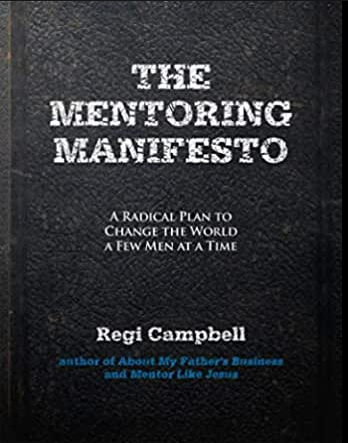The concept of mentorship dates back to approximately three thousand years ago when Homer gave a nurturing and supportive character in his classic epic — The Odyssey — the name Mentor.
The role of mentor and mentee are natural positions for people to take throughout their lives. While such relationships can form organically, proactive, intentional mentorships can create a lasting impact on the lives of both the mentor and mentee.
Students studying in college, for example, would do well to seek out the guidance of a faculty member with industry experience that aligns with their ambitions. Such relationships can provide invaluable  insight and support that often becomes a key differentiating factor in the success of one’s life and career.
insight and support that often becomes a key differentiating factor in the success of one’s life and career.
In The Mentoring Manifesto, Regi Campbell provides his readers with an innovative approach to the mentoring process. It is a thought-provoking meditation on the critical importance of mentor-guided mentorship and an ultimate guide on how to adopt a new mentorship approach he calls upside-down mentoring.
To learn more about how this style of mentorship can affect lasting change in mentors, mentees, and the communities of which they are a part, keep reading.
The Definition of Mentorship
The Merriam-Webster dictionary defines mentorship as “the influence, guidance, or direction given by a mentor.” The same source defines mentors as “trusted counselors or guides” and a mentee as “one who is being mentored.”
Notice the use of passive voice in the definition of mentee; while a mentee must execute their work in an impactful relationship with his or her mentor, the definition suggests that the most active party in the relationship should be the mentor as they are entrusted to influence, guide, and direct.
What is a Mentor?
Any person with life experience who agrees to guide another toward his or her goals can be considered a mentor. However, there are certain qualities that make some mentors outstanding, but I’ll cover more on that later.
What is a Mentee?
A mentee, by Campbell’s definition, should be selected by a mentor for their potential, teachability, and leadership abilities. In this way, a mentor shapes future generations by fostering growth in their community among the young mentees they believe will continue that tradition.
When under the guidance of a competent and inspiring mentor, mentees can undergo an immense amount of growth and development in a short period of time. That is a part of what makes the mentorship process so powerful.
Upside-down Mentorship
In his book, Regi Campbell elaborates on what it means to be a mentor. He believes that, when a mentorship begins, oftentimes it is sparked by a young person reaching out to an established figure for guidance and advice. This form of mentorship does result in a temporary relationship that can be rewarding for both parties but doesn’t necessarily provide a comprehensive approach to mentorship.
In the upside-down mentorship model, Campbell establishes the importance of proactivity on the part of the mentor. He believes mentors must take on an active role in the mentorship process. That means that, instead of waiting for a young person to reach out to them for a relationship, the mentor should actively seek out young people in their community to mentor.

In addition to intentionally selecting mentees, a mentor should also prepare a plan for the mentorship that helps mentees achieve significant growth.
Campbell explains that upside-down mentorship is undoubtedly the most effective form of mentorship because of the initiative taken on by the mentors who adopt it.
When done correctly, upside-down mentorship has the power to effect lasting change in future generations. One of the biggest impacts that Campbell notices in his mentorship relationships is the positive changes it brings to both the mentor and mentee’s families. He notes the gratitude of his mentees’ families as they witness the tremendous growth in their loved one.
In this way, upside-down mentorship has a positive effect on the entire community.
What Makes a Good Mentor?
In his book, Campbell demonstrates the necessity of a mentor who takes on the role with a sense of purpose and intention. It is one of the single most important factors in determining whether a mentor will be successful.
There are also other competencies that make mentors outstanding. They are as follows:
- A commitment to the success of others
- Strong leadership and teamwork abilities
- Excellent interpersonal skills
- A growth mindset
- Skills and experience in a specific industry or field
- Ethics, empathy, and trustworthiness
To provide their mentees with a worthwhile experience, mentors must feel a sense of accountability and responsibility for the well-being and growth of those who look up to them.
In his book, Campbell illustrates how a community can help mentors and mentees remain steadfast in their commitments and values. In his upside-down methodology, we learn that mentors are essential for growth, as they provide a watchful eye that can hold people accountable to their goals and commitments.
For this reason, great mentors foster a community of individuals and families who support one another and who understand and uphold the importance of strong values.
What Makes a Good Mentee?
As the role of a mentor requires a long list of strengths and competencies, mentees must also embody certain traits. Here are a few qualities that define a good mentee:
- Humility and open-mindedness
- Teachability and curiosity
- Strong interpersonal skills
- Listening skills and adaptability
- A willingness and excitement for trying new things
- Respect for the time and effort of others, in particular, the mentor
- Initiative and work ethic
- A willingness to fail and grow
What are the Responsibilities of a Mentor?
To develop a strong relationship between a mentor and mentee, the mentor must take on his or her role with a great amount of responsibility. As such, Campbell highlights the necessity of developing a plan when deciding how to mentor someone.
Here are three steps for developing a relationship that benefits both the mentor and mentee while also benefiting the entire community.
Campbell’s steps are as follows:
1. Choose a topic. A strong mentor selects lessons and areas for skills development that balance what the mentee excels at and what he or she most needs. Clearly articulated guidelines will help mentees understand where they should be focusing their mental energy.
2. Give homework assignments. Lasting change doesn’t occur over one mentorship session. Assigning work outside of meetings fosters a sense of accountability.
3. Layout a schedule. Define clear meeting times and adhere to them. A strong mentor displays the qualities he wishes to foster in his mentees. Responsibility and time management will go a long way to establishing oneself as a positive role model.
What are the Responsibilities of a Mentee?
On the opposite side of the same coin, the responsibilities of a mentee include developing open communication with one’s mentor, taking all homework assignments seriously, and respecting the time and experience of the mentor.
When at its best, the relationship between a mentee and mentor should be symbiotic. It should never feel too one-sided. Of course, as a mentee, you can come prepared with questions to ask your mentor, but it’s important to remain open to what the mentor has to offer.
It would be a sensible assumption as a mentee to remember good mentor acts with intention. A mentor selects mentees because they believe they are worthy of their time and effort. A mentee, therefore, should never underestimate his or her ability to help their mentor, if they see an opportunity to do so.
Signs of a Strong Mentor and Mentee Relationship
Strong mentors help their mentees become strong mentors. The symbiotic relationship should be one of full-circle reciprocity and commitment to the betterment of the community. Through the development of strong relationships that build trust and encourage positive behaviors, mentors can impact the world in a lasting way.

Mentors, let me ask you this: how might your community be positively impacted if you committed to mentoring a certain number of young individuals each year?
In his book, Campbell illustrates the power of multiplicity. Imagine your impact as a mentor if each of the mentees you took under your wing went on to mentor younger people themselves as they grew more experienced. An unbreakable cycle of support and encouragement would help to create a better world for all of us. As a mentor, you possess this power, and I encourage you to take it on with radical initiative and responsibility.
As for mentees, Campbell encourages you to remain open and vulnerable while you are taking part in a mentorship.
In a mentor and mentee relationship, nothing is more critical than trust. Aside from the countless benefits of being and having a mentor, when both parties respect and trust each other, there is no limit to what they can accomplish together.
To learn more about mentorship and leadership check out some of my free educational resources. Read about tribal leadership, biblical leadership, and communication so you too can be an agent of positive change in your community or organization.







